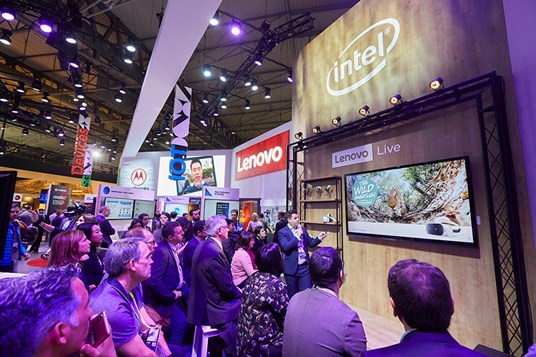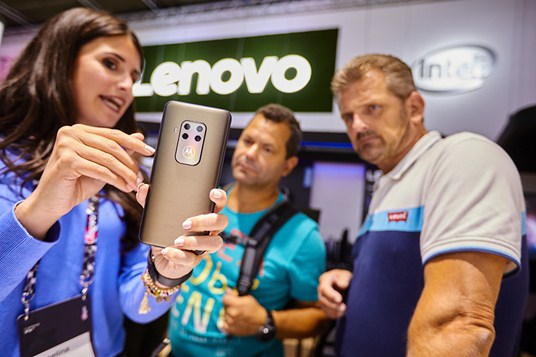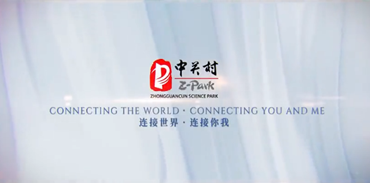Popularizing tech the Chinese way

An employee of Lenovo introduces the company's technologies at the MWC Barcelona in Spain in February 2019. [Photo provided to China Daily]
Lenovo's worldwide expansion brings the brand's top-quality products to consumers
When you ask a Danish cabby how to reach the Denmark headquarters of Chinese tech heavyweight Lenovo Group Ltd, it's likely he or she will proactively find the quickest route to the building in Soborg, about 10 km northwest of capital Copenhagen. The taxi driver may even attest to the good quality of the brand's products.
That is because the local unit of the company has been championing a mission called Taxi Driver, which is helping make Lenovo a household name in Denmark.
Currently, Lenovo accounts for more than 50 percent of the PC market in Denmark, according to data from market research company International Data Corp.
It is part of the Beijing-based company's broader efforts to earn the trust of consumers and enterprise customers on the global stage. Currently, the Chinese company operates in more than 180 countries and regions, and has 15 research and development bases around the world. Five Lenovo devices are sold every second.
"We are a global company, with Chinese heritage, founded in China, and we believe globalization is good for both consumers and businesses," said Gianfranco Lanci, president of Lenovo.
He said Lenovo is a strong believer in globalization and operates always with focus on local people, local management and compliance with the local law. The company has a very strong manufacturing base not only in China but elsewhere. It also boasts a deeply integrated global supply chain.
Asked how companies could win trust in sophisticated global environments, Lanci said: "The most important thing is to be as open as you can."
Lenovo started to build its international presence in 2004 after it acquired IBM's PC unit making the popular ThinkPads. "Lenovo PC acquired a business which was big but mainly limited to commercial business. We have been able to take this business, fix certain things and grow the business. We've been able to keep up in terms of innovation and product development with all the keys coming from IBM," Lanci said.
He recalled that when he joined Lenovo in 2012, he saw a lot of people who came from IBM. They are all still here, which attests to the buyer being a good employer post-acquisition. "Usually, when you acquire a company, you tend to think that you must be better than the other people because you are the buyer. But Lenovo did exactly the opposite, they said let's look what's good and what's not good and get rid of the things that are not good."

An employee of Lenovo showcases the latest smartphone model of Motorola in 2019 IFA consumer technology fair in Berlin in September 2019. [Photo provided to China Daily]
A similar thing happened after Lenovo acquired Motorola Mobility from Google Inc for $2.9 billion in 2014. Though it cost some time for Lenovo to fully absorb the impact of the merger, the company's mobile business, which includes smartphones, has finally become profitable for four consecutive quarters.
"In Latin America, we are running at between 18 and 20 percent market share, and in the US, we have seen about 5-percent year-on-year growth and 15-percent quarter-on-quarter growth in terms of activation, and both of them are very profitable. Now, the next step is really how we can continue to grow and maintain profitable growth," Lanci said.
The company will step up investment in Europe, with focus on four to five countries, including the UK and Italy, to drive sales of its smartphones in the region. It will also intensify resource deployment in emerging markets, including some Asia-Pacific countries.
"We can leverage our sound PC infrastructure in these countries for mobile phones," Lanci said.
In the quarter ended September 2019, Lenovo posted $13.5 billion in revenue, marking its ninth consecutive quarter of year-on-year growth. The company's net income also increased 20 percent year-on-year to $202 million.
Lenovo's good performance in the PC business, and emerging returns from new businesses are encouraging it to press ahead with its transformation into a software and services provider.
From July to September, Lenovo shipped 17.3 million units of PCs worldwide, growing 7.1 percent year-on-year and grabbing a global market share of 24.6 percent, according to data from market research company IDC.
"Commercial demand (for PCs) should accelerate as enterprises work through the remainder of their Windows 10 migration," IDC research vice-president Linn Huang said in a statement.
Lenovo's Lanci predicted that the global PC market is likely to remain relatively flat or record slight growth in 2020. As the Windows 10 refresh cycle in the commercial market will continue to contribute to the gain, the sector will likely continue to face a shortage in CPU supplies, he said.
According to Lenovo, although global trade and geopolitical uncertainties persist, they continue to have a negligible material impact on the financial performance of the company.
"Lenovo has always been a beneficiary and promoter of globalization. We have always promoted the integration of globalization and localization with an attitude of openness and cooperation. Lenovo firmly supports the rule-based global economic and trade relations," said Yang Yuanqing, chairman of Lenovo.

